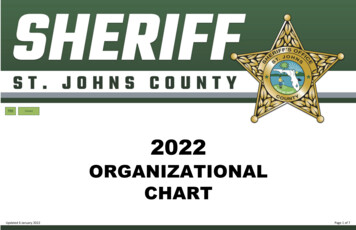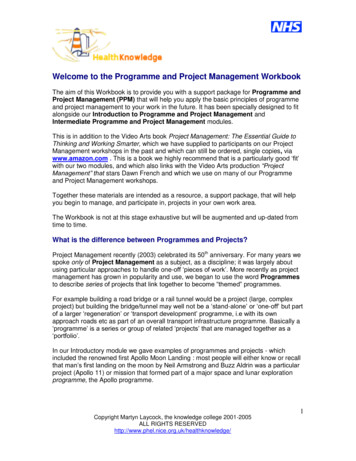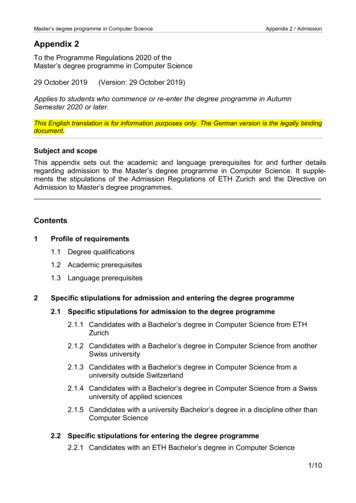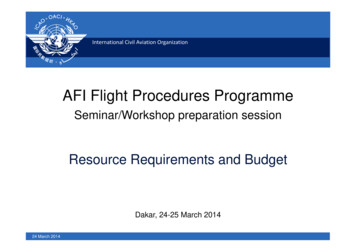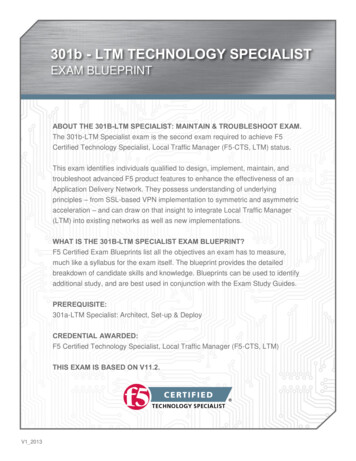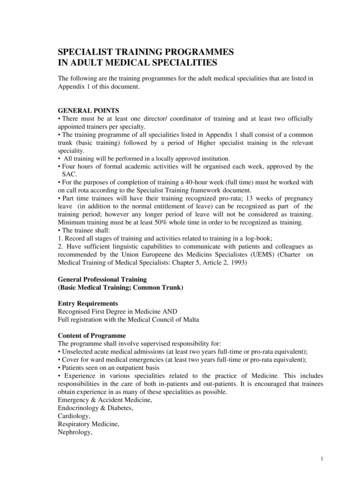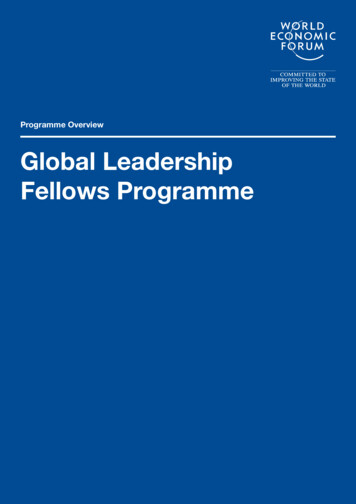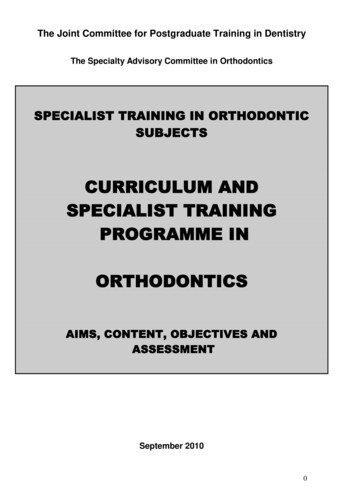
Transcription
The Joint Committee for Postgraduate Training in DentistryThe Specialty Advisory Committee in OrthodonticsSPECIALIST TRAINING IN ORTHODONTICSUBJECTSCURRICULUM ANDSPECIALIST TRAININGPROGRAMME INORTHODONTICSAIMS, CONTENT, OBJECTIVES ANDASSESSMENTSeptember 20100
SAC Orthodontic Curriculum September 2010page 1TABLE OF CONTENTSPageAbbreviations used throughout document Introduction and Background .241. Rationale . . .1.1- Purpose of the curricula . 1.2- Curriculum development .1.3- Context of training 1.4- Entry criteria .1.5- Duration of training 1.5.1.- Breaks in training .1.5.2.- Individual needs: Flexible and part-time training .445567772. Content of Learning . 2.1- Aims of the training programmes . .2.2- Objectives of the 3 year programme .2.3- Generic knowledge, skills, attitudes. .2.4- Orthodontic specialty specific knowledge, skills, attitudes . . 2.5- Sequencing of learning and experience 2.6- Methods of assessment 7778846463. Model of Learning . . 473.1 -How learning will be achieved . 473.2 -Distribution of time within the training programme .473.2.1 - The 3 year programme . 473.3 -Clinical experience and caseload . . 483.4 -Out of programme training 484. Learning Experiences . 494.1- Training Capacity of the Programme . 495. Supervision of trainees and feedback . 495.1 -Educational Support 495.2 -Trainer and Supervisors’ Training 506. Managing curriculum implementation . 507. Curriculum review and update . 518.Equality and diversity . 518.1- Statutory responsibilities . 519.References . 5211. Appendix 2 – Modular training pathways in orthodontic subjects (syllabus) 531
SAC Orthodontic Curriculum September 2010page 2Abbreviations used throughout the document:ABSTDAdvisory Board for Specialty Training in DentistryARCPAnnual Review of Competence ProgressionBDSBachelor of Dental SurgeryBOSBritish Orthodontic SocietyCCSTCertificate of Completion of Specialist TrainingCOPDEND Council of Postgraduate Dental DeansCPDContinuing Professional DevelopmentDDSDoctor of Dental ScienceDOHDepartment of HealthDOPSDirect Observation of Procedural SkillsDPCODiploma in Primary Care OrthodonticsDwSIDentist with Special InterestFDSFellowship of Dental SurgeryFTTAFixed Term Training Appointment (from July 2010 these are known as Post-CCSTtraining posts)GDCGeneral Dental CouncilGPTGeneral Professional TrainingICTInformation and Communication TechnologyISFEIntercollegiate Specialty Fellowship ExaminationJCPTDJoint Committee for Postgraduate Training in DentistryJCSTDJoint Committee for Specialist Training in DentistryMCQMultiple Choice QuestionsMiniCEXShort Clinical Examination ExerciseMFDSMembership of the Faculty of Dental SurgeryMJDFMembership of the Joint Dental FacultiesMOrthMembership in Orthodontics2
SAC Orthodontic Curriculum September 2010MSAMultiple Short AnswersMSFMulti-source FeedbackNTNNational Training NumberOSCEObjective Structured Clinical ExaminationPCTPrimary Care TrustRCSRoyal College(s) of SurgeonsRITARecord of In-Training AssessmentSACSpecialty Advisory CommitteeSCRStructured Clinical Reasoning TestSDEBSpecialist Dental Education BoardTPDTraining Programme Directorpage 33
SAC Orthodontic Curriculum September 2010page 4This document has been prepared with due regard to the changing circumstances at the time ofpublication. The Specialist Advisory Committee (SAC) in Orthodontics endeavours to maintain its policydocuments as current as possible at the time of preparation. The SAC in Orthodontics takes noresponsibility for matters arising from changed circumstances or information or material which may havebecome available subsequent to the publication of this document.Introduction and BackgroundThe planning of this curriculum document for training in orthodontic subjects began in 1994 when itbecame necessary for the development of a national plan for structured training following the CalmanReport and the first Chief Dental Officer’s Report.In November 1995 the Curriculum Working Party of the SAC produced a curriculum together with Aims,Objectives, Content, Learning Outcomes and Assessments leading to the Membership examinations ofthe Royal Colleges (MOrth RCS) for all trainees in orthodontics. The curriculum was set out, inaccordance with modern educational practice, in a modular format to assist teaching and assessment. Inresponse to a request from the Specialist Dental Education Board of the General Dental Council in 2008,a new version has been produced to reflect the need for an outcome based curriculum which is indicativeof the competencies required at the varying levels of training within the specialty together with theknowledge, skills and attitudes achieved by the trainee in acquiring those competencies. The extensiverevision of the curriculum has been based on current thinking and the requirements for: Greater protection of the public by providing clear information as to the level of trainingachievedImproved access to specialist training by general practitionersGreater flexibility to training through the availability of both full and part-time trainingpathwaysGiving appropriate recognition for accredited prior learningProducing a competent workforce with the appropriate skills and knowledge necessary tomeet the varying levels of treatment complexity, as well as considering the relative needand demand of potential patients.1. Rationale1.1 Purpose of the CurriculumIn developing the curriculum, the SAC have been mindful of the requirements to both protect the publicand to train a competent workforce with the appropriate skills and knowledge necessary to meet thevarying levels of treatment complexity, as well as considering the relative need and demand of potentialpatients.The majority of patients in the current population of the United Kingdom have a treatment complexity thatcan be managed by a Specialist Orthodontist. The purpose of the 3 year curriculum is to enable trainees(StRs) in Orthodontics to achieve the level of competence expected in order to provide appropriate carefor this group of patients normally treated in the primary care setting.It is essential that the public have a clear understanding as to the level of training undertaken by anorthodontic practitioner and that the ‘specialist’ has the appropriate knowledge and skills to provide carefor the needs of a specific patient group.This curriculum is not intended to provide competence in the management of patients requiring morecomplex multidisciplinary medical and/or other dental specialty care. It is expected that ‘specialists’providing such care would currently undertake an extended, additional period of training that equips them1to deliver more complex maxillo-facial orthodontic treatments and associated services . Both the4
SAC Orthodontic Curriculum September 2010page 5Specialist Dental Education Board and the GDC Education Committee appreciate the importance of adifferent, and more appropriate, quality assured training for those who wish to be competent in themanagement of these multidisciplinary patients. This will be considered further as part of the GDC'sSpecialist List Review scheduled for 2011.The requirement to train a separate specialist workforce with the different, yet appropriate, knowledge,skills and attitudes to manage this specific group of highly complex patients supports the agreed 18 week2Commissioning Pathway , which has been accepted by both the DoH and the British Orthodontic Society.The details of how the training to manage these separate groups of patients compares can be seen atAppendix 1 and also at the following link: ttraining/higher-specialist-training-docs3The programmes include all the features of the European Erasmus training programme and fulfil therequirements of the directives of the Commission of the European Communities on Dental Education45regarding the education of orthodontists , the Advisory Committee on the training of Dental Practitioners6and the World Federation of Orthodontists guidelines for postgraduate orthodontic education .The training programmes are founded on a training centre, normally comprising a university dental schooland dental hospital together with other associated, recognised and validated training environments.Completion of the 3 year specialist training programme is marked by the successful completion of one ofthe Membership examinations of the Royal Surgical Colleges (MOrth RCS). It is anticipated that aTricollegiate Membership examination will be developed in the near future.All trainees on CCST training programmes will be required to achieve the same standards of competenceand will hold National Training Numbers (NTNs) to enable monitoring of their training by the PostgraduateDeaneries in conjunction with the SAC. This is as defined in the Memorandum of Understanding between7the GDC and members of the JCSTD (2008) .The 3 year full time programme (or its part time equivalent) will lead to a CCST in Orthodontics, subject tothe satisfactory completion of the in-training assessments.1.2 Curriculum developmentThe curriculum has been written, developed and modified by a working group of the SAC in Orthodontics;Professor Nigel Hunt (Chair), Professor Fraser McDonald (RCS England), Professor Jonathan Sandy(RCS Edinburgh) and Mr Jonathan Sandler (Consultant Group of BOS), in conjunction with the LeadPostgraduate Dean for Orthodontics (Mrs Elizabeth Jones). The curricula have subsequently beendiscussed and approved by the full SAC in Orthodontics which, in addition to the above, includesrepresentatives from the Royal Colleges and the constituent groups of the British Orthodontic Society; MrStephen Rudge (Consultant Group), Mr Ivan Connolly (RCPS Glasgow), Dr Friedy Luther (UniversityTeachers Group), Mr Chris Lowe (Orthodontic Specialists Group), Mr Mike Smith (OrthodonticCommunity Group) and Ms Sophia Wahla and Ms Sally Walker (Training Grades Group). The curriculahave also been modified in the light of comments from a lay representative, Mr Robert Posner (PositiveCommunications).The structure and curriculum has been presented to, and approved by, the Executive of the BritishOrthodontic Society (BOS), the Education Committee of the BOS as well as the Chairs of the BOSconstituent groups, including the Training Grades Group. The curriculum has also been approved by theEducation Committee of the GDC, the JCSTD/ JCPTD and the SDEB.1.3 Context of trainingTraining and education should be systematically planned in both the clinical and academic environments.The educational contract should be structured and, in this context, training should take precedence over5
SAC Orthodontic Curriculum September 2010page 6service provision. Few hospitals and clinics can provide complete training and hospital departments arenormally expected to link with University Dental Schools, primary care settings and other trainingenvironments to provide all aspects of teaching and training as appropriate. Educational plans should beco-ordinated so that the opportunities available in approved training environments can be linked to forman orthodontic training network. Training has been planned in modules linked to various generic andspecialty specific topics.In preparation for specialists undertaking and maintaining a modern evidence-based approach toorthodontic practise, achieved through continuing professional and personal development, it is expectedthat trainees have personal research training and experience. This experience is expected for all traineesand should be structured to the eventual career intentions of the trainee. The research componentshould fulfil the minimum M level requirements of the Quality Assurance Agency and may take the formof the satisfactory submission of a research dissertation (for example as part of an MSc, MClinDent, DDSor equivalent), and/or two papers in appropriately peer reviewed journals submitted on work undertakenduring the training period. Academic trainees would normally be expected to spend time acquiring a PhDor other higher research qualification.Trainees must be informed of assessment processes and the part played by Training ProgrammeDirectors, Postgraduate Deaneries, and the SAC in Orthodontics, the ABSTD, the JCPTD and theGeneral Dental Council. Trainees should take part in local, regional and national educational events.1.4 Entry CriteriaFully registered dental graduates may apply for the specialty training programmes usually following, atleast, 2 years foundation training or its equivalent, in a practice or hospital environment either within theUK or the European Union.Entry is competitive and the possession of the MJDF/MFDS/FDS of the Royal Colleges (or theirequivalent), whilst not essential, may be used as a marker of the completion of the foundation period.Similarly, candidates may consider it desirable to be in possession of the Part 1 MOrth examination,which covers applied science in relation to orthodontic practice, prior to commencing specialist training.This paper based examination can be taken at any time following basic dental qualification and isavailable to candidates from any country. An on-line version is currently being developed. Thosecandidates who have passed the Part 1 MOrth examination would gain exemption from the relevantacademic modules of the curriculum (see Appendix 1). The selection panels will also be looking forevidence of motivation, commitment to the specialty, a logical career progression and continuingprofessional development.A more flexible approach to entry to specialty training is being encouraged. Applicants who havesuccessfully completed an approved training programme leading to the Diploma in Primary CareOrthodontics (DPCO) of the Faculty of General Dental Practice (UK) will be given appropriate exemptionfrom those parts of the academic modules covered in the specialist training programmes as part of theiracademic accredited prior learning (see Appendix 1). It should be noted that in view of the longitudinalnature of orthodontic care, the clinical component of such ‘top-up’ training will still be undertaken over aminimum three year period.All training posts in orthodontics should be advertised in the British Dental Journal in the first instance.Other advertisements, coordinated through the respective Deanery, may be undertaken depending uponlocal recruitment needs.6
SAC Orthodontic Curriculum September 2010page 71.5. Duration of trainingThe training programme leading to the CCST in Orthodontics will be not less than 3 continuous years offull-time training or the equivalent part-time training (maximum time in training 6 years).Locum experience would not normally be accepted as part of the 3 year programme.1.5.1. Breaks in trainingThe longitudinal nature of orthodontic treatment provision means that an interruption in training may havea deleterious effect on the trainee’s knowledge and clinical skills acquisition. When there has been anabsence from training in excess of three months, the Postgraduate Deanery must be notified and they, inconjunction with the SAC in Orthodontics, will determine a revision of the training period and the clinicalprogramme that the trainee will be expected to complete on resumption of training.1.5.2. Individual Needs: Flexible and Part-time TrainingFlexible (Less than full time) Training over a more extended period for those with non-professionalcommitments or health issues can be arranged. Flexible trainees must complete the curriculum within apro-rata training experience. Full-time trainees can apply through the Postgraduate Deaneries to becomeflexible trainees and flexible trainees can apply to revert to full-time training by arrangement and with theapproval of the Postgraduate Dental Dean and the TPD. The interruptions in training noted above applyto all trainees irrespective of whether they are full-time, part-time or on a flexible programme.Part-time programmes will be similar to flexible training schemes, and involve competitive entry. For thoseopting for a part-time training, the trainee must be flexible in the sessions worked per week over thetraining period in order to attend those aspects of additional teaching and training required to completethe appropriate curriculum.The total length of flexible and part-time training should not be less than that of full-time training. Flexibleand part-time programmes would normally be for a minimum of six sessions per week.2. Content of Learning2.1 Aims of TrainingThe trainee should acquire the appropriate knowledge, attitudes and skills of a Specialist Orthodontist.Trainees should possess a sense of professionalism, interest and enquiry. These characteristics shouldencourage the specialist to maintain competency throughout their career by the continuous pursuit ofContinuing Professional Development.2.2 Objectives of the 3 year programmeOn completion of training the graduate will demonstrate the following aptitudes:Generic Specialist Skills A professional and ethical approach to patient care. A professional attitude to all members of the dental team. A scientific attitude, an inquiring mind and the stimulation of professional curiosity. A thorough understanding of scientific methodology. An ability to interpret the relevant literature. An awareness of current legislation and working practices relating to the practice of dentistry. An ability to develop themselves by both reflective practice and self evaluation.7
SAC Orthodontic Curriculum September 2010 page 8An ability to teach (this includes all members of the dental team).An ability to promote and apply dental health education.Orthodontic Specific Specialist Skills Diagnose anomalies of the dentition. Detect deviations in the development of the dentition, of facial growth and the possession offunctional abnormalities. Evaluate the need for orthodontic treatment. Formulate a treatment plan and predict its course. Carry out interceptive orthodontic measures. Execute simple and complex treatment procedures. Evaluate orthodontic progress and treatment outcomes. Possess an overview of the multidisciplinary approach for the treatment of dentally and medicallycompromised patients. Be able to acquire and interpret research information and data. Be able to prepare oral and written clinical and research findings.2.3 Section A - Generic Knowledge, Skills and AttitudesModule 1 Module 2 Module 3 Module 4 Module 5 Module 6 Module 7 Module 8 Module 9 -Cell and Molecular Biology with GeneticsEmbryology, growth and development of the face and jawsPsychologyResearch with ICTRadiological Imaging TechniquesOral HealthDental Health EducationHealth and SafetyClinical Governance2.4 Section B – Orthodontic Specialist Specific Knowledge, Skills andAttitudesModule 10 - Normal and Abnormal Development of the DentitionModule 11 - Temporomandibular Dysfunction and OrthodonticsModule 12 - Tooth Movement and Facial OrthopaedicsModule 13 - Orthodontic Materials and BiomechanicsModule 14 - Aetiology of MalocclusionModule 15 - Airway, Craniofacial Development and MalocclusionModule 16 - Diagnostic ProceduresModule 17 - Treatment PlanningModule 18 - Growth, Treatment Analysis and CephalometryModule 19 - Long-term Effects of Orthodontic TreatmentModule 20 - The Iatrogenic Effects of Orthodontic TreatmentModule 21 - Epidemiology in OrthodonticsModule 22 - Orthodontic Literature and ResearchModule 23 - Removable AppliancesModule 24 - Functional AppliancesModule 25 - Extra-Oral AppliancesModule 26 - Fixed AppliancesModule 27 - Retention AppliancesModule 28 - Guiding the Development of the OcclusionModule 29 - Adult Orthodontics8
SAC Orthodontic Curriculum September 2010page 9Module 30 - Orthodontics and Minor Oral SurgeryModule 31 - Orthodontics and Restorative DentistryModule 32 - Overview of Multidisciplinary Management of Facial DisharmonyModule 33 – ManagementModule 34 – Teaching and communication9
SAC Orthodontic Curriculum September 2010page 10SECTION A GENERIC KNOWLEDGE, SKILLS ANDATTITUDES10
MODULE 1Cell and Molecular BiologyObjectiveThis module isintended to provideinformation regarding: Cells and moleculesas they relate to thedevelopment andgrowth of thecraniofacialcomplex, and theirrelevance to theassessment andtreatment ofpatientsKnowledgeSkillsAttitudes Describe boneformation and remodellingin health and disease Apply knowledgeof craniofacialbiology to theassessment andtreatment ofpatients Recognize theimportance ofcell biology fornormal andabnormalcraniofacialdevelopment Describe both normaland abnormaldevelopment of teeth andsurrounding structuresTeaching and LearningMethods Attend traineeseminars withindepartment Web based e-learningsources Independent studyAssessment Written examination Structured ClinicalReasoning (SCR) Workplace basedassessment Attendance atsuitable course Attendance atsuitable meetings11
SAC Orthodontic Curriculum September 2010page 12MODULE 2 Embryology, growth and development of the face andjawsObjectiveThis module isintended to provideinformation regarding: Growth anddevelopment ofstructures of thehead and neck, andtheir relevance tothe assessment andtreatment ofpatientsKnowledgeSkillsAttitudes Describe normal andabnormal facialdevelopment includingcommonmalformations Apply knowledgeof facialembryology,growth anddevelopment tothe assessmentand treatment ofpatients Recognizeimportance ofdevelopmentalbiology for normaland abnormal facialformation Recognize theimportance ofpatterns of facialgrowth in relation topatient assessmentand treatmentTeaching and LearningMethods Attend traineelectures / seminarswithin thedepartment Independent study Attendance at suitablecourseAssessment Written examinationand/or viva (StructuredClinical Reasoning) Objective StructuredClinical Examination(OSCE) Workplace basedassessment Attendance atsuitable meetings Web based e-learningsources12
SAC Orthodontic Curriculum September 2010page 13MODULE 3 PsychologyObjectiveThis module isintended to provideinformation about andexperience in: The psychologicalbasis of patients atassessment, duringorthodontictreatment planningand delivery andsubsequent totreatmentKnowledgeSkillsAttitudes Describe normalpsychologicaldevelopment fromchildhood to adulthood Apply knowledgeof psychologicaldevelopment tothe assessmentand orthodontictreatment ofpatients Recognize theimportanceand appliesknowledge ofpsychology fornormal andabnormal patientprofiles Describer normal andabnormal psychologicaldevelopment includingdisorders of personalityTeaching and LearningMethods Attend traineeseminars within thedepartmentAssessment Independent study OSCE Written examinationand/or viva (StructuredClinical Reasoning) Attendance atsuitable course Attendance atsuitable meetings Web based e-learningsources13
SAC Orthodontic Curriculum September 2010page 14MODULE 4 Research with Information and CommunicationTechnology (ICT)ObjectiveThis module isintended to provideinformation about andexperience in: Current technologyto support dataacquisition andresearchKnowledgeSkillsAttitudes Describe the operationof information andcommunicationtechnology Apply knowledgeof informationandcommunicationtechnology to thedelivery of care topatients Recognizeimportance ofappropriateinterpretation ofresearch tosupport delivery ofcare to patients Identify and use searchengines and protocols Discriminate evidencebased websitesTeaching and LearningMethods Attend traineeseminars within thedepartment Independent study withICT and web based elearning sources Attendance atsuitable courseAssessment Workplace basedassessment Written paper(includingMCQ / MSAs) On-line assessmentand viva Attendance atSuitable meetings14
SAC Orthodontic Curriculum September 2010page 15MODULE 5 Radiological Imaging TechniquesObjectiveThis module isintended to provideinformation about andexperience in: Principles andpractice of imagingand the relevantimaging technologyKnowledgeSkills Explain the operation ofcontemporaneousimaging equipmentwithin legislation Apply knowledgeof imagingtechniques to thediagnosis andmanagement oforthodonticpatients Describe radiationprotection and ALARAguidelinesAttitudes Recognize theimportance andappropriate use ofimaging for thebenefit of thepatient Exhibit anawareness of thelegal basis ofprotecting thepatient and staffTeaching and LearningMethods Attend traineeseminars / tutorialsAssessment Attendance atsuitable course Case presentations Independent study Web based e-learningsources On-line, writtenassessment OSCE SCR15
SAC Orthodontic Curriculum September 2010page 16MODULE 6 Oral HealthObjectiveThis module isintended to provideinformation about andexperience in: The importance oforal healthprinciples andpracticeKnowledge Identify oral healthissues in patientsreceiving specialistcare Describe indices oftreatment need andcomplexitySkills Apply knowledgeof oral healthstrategies todiagnosis andmanagement ofpatientsAttitudes Recognize theimportance of oralhealth care in themanagement ofpatients Recognize theneed to informpatients of therelevant risks andbenefits oftreatment
an orthodontic training network. Training has been planned in modules linked to various generic and specialty specific topics. In preparation for specialists undertaking and maintaining a modern evidence-based approach to orthodontic practise, achieved through continuing professional and personal development, it is expected
